6+ Sample Employee Progress Report
-
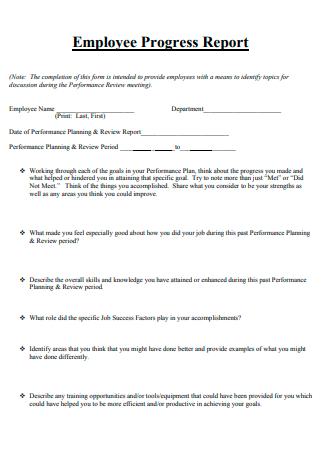
Employee Progress Report Template
download now -
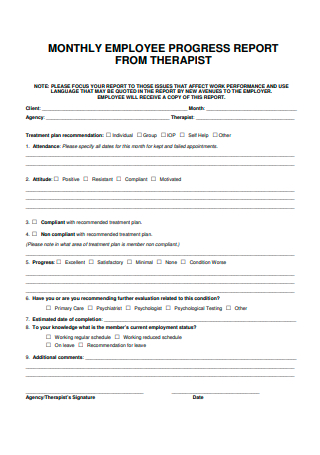
Monthly Employee Progress Report
download now -
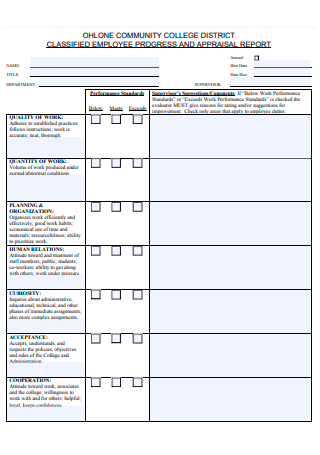
Employee Progress and Appraisal Report
download now -

Work Against Employee Progress Report
download now -
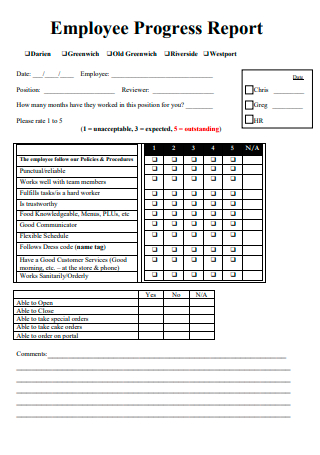
Formal Employee Progress Report
download now -
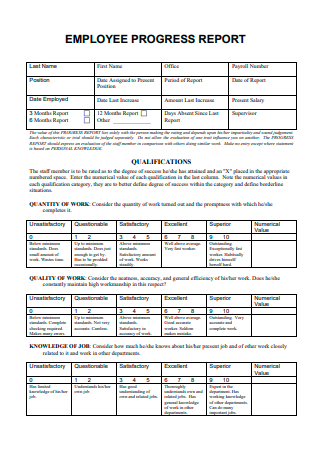
Employee Progress Report Example
download now -
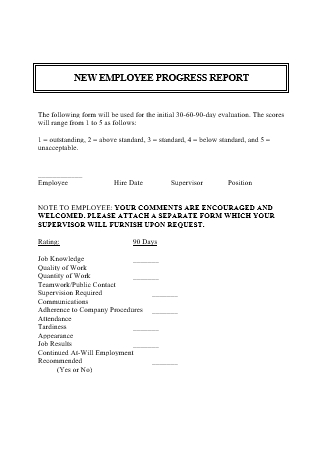
New Employee Progress Report
download now
FREE Employee Progress Report s to Download
6+ Sample Employee Progress Report
What Is an Employee Progress Report?
Benefits of Employee Progress Report
Types of Employment
Tips for Providing Effective Progress Feedback
How to Write a Progress Report
FAQs
Why is employee reporting important?
What should a weekly report look like?
What is the format of a report?
What Is an Employee Progress Report?
A report on employee progress details an employee’s performance, activities, successes, and accomplishments during a specific time. It is what it sounds like: a document describing how far you have progressed on a project. It describes the actions you’ve executed, the tasks you’ve done, and the milestones you’ve attained relative to your project plan. According to statistics, employee appreciation was the most crucial factor for 37 percent of employees.
Benefits of Employee Progress Report
As a leader, you must be aware of the actions of your employees. You do not need to micromanage and be mindful of everything your staff does. Nonetheless, you must be aware of the status of your projects, who is struggling, and which issues you must prioritize and assist your team with. We have compiled a list of the advantages of a flexible approach to your employees’ weekly workload.
Types of Employment
There are five different types of jobs, each based on the nature and several tasks an employee is expected to do. The employer sets the terms and conditions of the employment contract. The contract structure should be in line with labor laws and regulations.
Tips for Providing Effective Progress Feedback
Evaluations assist management in prioritizing personnel for raises, promotions, or termination. Progress reviews can help employees refocus their workload and motivation based on their strengths and areas for growth. Making progress reviews tool employees can use to identify their strengths and flaws is essential. The following seven tips will assist you in creating an excellent evaluation:
1. Maintain accurate records of each employee’s position and Keep performance logs
When considering how to write a proper evaluation, personalize the review to the employee in question. This approach includes noting their position and comparing their performance to the company’s expectations. In addition, make regular notes regarding productivity, teamwork, and interpersonal skills in preparation for an employee performance review. Alternatively, some employers request that team members write a self assessment summarizing the activities they accomplished and the results they achieved during the period in question. It is typically easier for an employee to remember precise work-related facts than a manager, especially one with several direct reports. In this approach, comparing your notes during the review can be beneficial.
2. Consult other management and be direct
Before concluding an employee review, you should, if applicable, inquire with other managers or supervisors about the individual. Once upon a time, managers were advised to sandwich potential criticism between good remarks. Sandwiching is a tactic that is strongly prohibited. Employees are not fooled. When praise is used to transition into negative feedback, it is diluted. Furthermore, postponing the inevitable produces worry for both the reviewer and the employee. Be forthright while offering negative feedback.
3. Notate possibilities for enhancement
Each critique of an employee’s work should contain suggestions for how the employee might improve. Often, suggestions for improvement are equally valuable as favorable remarks and can provide good direction for goal-setting. Be direct and specific about what you expect the employee to accomplish and advise to help them achieve these goals.
4. Solicit a dialogue
During a performance review, it is imperative to obtain input from the evaluated employee. The employee should do most of the talking for these evaluations to be beneficial. A portion of the difficulty of performance reviews may stem from the employee’s perception that this evaluation is unilateral. If you do most or all of the talking, employees may see the evaluation as a reprimand and respond negatively. Ask staff questions and encourage them to discuss how they can improve and what they enjoy most about their jobs. You might also urge them to establish their professional objectives. Pay heed to the employee’s comments and concerns if they have offered a self-evaluation. Allow them the opportunity to evaluate their performance on the job. You may discover they need extra training, new chances, or other actions to advance inside the organization.
5. Ask the employee the correct questions and communicate often
An evaluation of performance should never be unilateral. What the employee says is equally important as what you communicate to them. Ask questions that encourage feedback and honesty from the employee. In addition, you can make the performance review process less stressful by maintaining regular contact with the employee between reviews. These discussions may involve informal performance evaluations or common words of support. If the employee communicates with you daily, it may be simpler for you to evaluate their work and for them to take your feedback report.
6. Complete the evaluation with the subsequent steps
Make that you and the employee understand the following actions before the conclusion of the evaluation meeting. Developing a plan of action is vital. What specific steps must the employee take to improve? How will these actions be evaluated? What will you do as a manager to assist the employee in achieving success?
How to Write a Progress Report
Have you ever been unable to begin writing, tapping your pen, or staring at a blinking cursor? This is common while writing progress reports, particularly for individuals whose occupations do not generally demand drafting lengthy paperwork. People may find it challenging to compose these reports since they believe they are not writers. But that is just mental. Reports do not require complex language; the simpler the language, the better. Here are some tips for writing an essay.
Step 1: Consider it a Q&A
Because that is its essence, imagine your manager, coworkers, or client asking you questions and responding. Suppose, for instance; you are in charge of food concessions for a weekend festival featuring food stalls and music. The project plan may require you to have received at least ten letters of intent (LOI) before the end of the first month. Then, your progress report would list the companies or entrepreneurs that have submitted LOIs, along with a description of their company and plans for their food booths. If negotiations are underway with other businesses that have not yet offered LOIs, you may highlight this and indicate when they are expected to do so. Alternatively, if you have not attained your goal, you must explain and describe your efforts and the anticipated timescale for reaching the desired results.
Step 2: Use direct and basic language
This does not preclude the use of technical language. For instance, if you are in the building industry, you do not need to avoid terminology such as “tender,” “variant,” and “risk management.” But otherwise, communicate clearly. Use concise and straightforward language. In corporate writing, a common misperception is that complexity impresses. In reality, it just leads to uncertainty. Communicating clearly about your topic demonstrates that you thoroughly understand it. If we rewrite this to retain the verb, we would say “transforming verbs into nouns.” It is easier to understand and to the point.
Step 3: Avoid passive voice usage whenever possible
In formal documents that don’t allow the first-person point of view, you sometimes have to use the passive voice. But if you do it right, it can help make your report more attractive. To make that sentence active, you need to give it a player, which in this case is the team, as in: “The team researched possible food concessionaires.”
Step 4: Be specific
A study published in the Journal of Cognitive Neuroscience indicated that using concrete language excites the brain’s left and right hemispheres. In contrast, abstract phrases tend to stimulate only the left hemisphere. While the jury is still out on precisely how word meanings are represented in the mind, we can all agree that “a cheerful sound” is less evocative than “tinkling bells.” Using the previous example, “studied potential food concessionaires” lacks a visual connotation. In contrast, “compiled a list of fifty probable food concessionaires” is more concrete, especially when food products are specified.
Step 5: Explain jargon if needed and Stick to facts
This depends on who will be reading your report and whether you are using highly specialist lingo that only team members would understand. For instance, in a report written by a construction team and addressed to the project manager, construction jargon may be used because the receiver understands it. Additionally, refrain from offering an opinion unless it pertains to the project. For instance, your role could consist of analyzing data and providing analysis and forecasts. In this scenario, you may express your speculation and opinion, provided you support them with proof.
Step 6: Spell out acronyms and use images to supplement the text
Do not assume that everyone who reads the report will be familiar with the acronyms you employ without explanation. For example, in construction work, SWMS should initially be written as a “safe work method statement.” Pre-start checks should be written as “pre-starts.” Avoid writing large sequences of numbers in a single sentence. Try utilizing a variety of graphs, tables, and charts, mainly when dealing with a series of numbers. The hiring progress report template shown below is a good illustration.
FAQs
Why is employee reporting important?
For many employees, it is essential to demonstrate their accomplishments. Employees want to know that their boss cares enough about them to pay attention to their work, and employee status reporting allows you to show this.
What should a weekly report look like?
Reports should be concise and unambiguous. They should not ramble on routine or weekly tasks and include all you’ve accomplished during the week. The length of your weekly activities report should not exceed one page if you’re handwriting it or three to ten items if you’re using the software.
What is the format of a report?
With headings and subheadings, reports are divided into sections. Reports may be academic, technical, or business-oriented and contain actionable suggestions. The purpose of a report is to give information about a situation, project, or procedure and describe and assess the topic at hand.
An employee is entrusted with completing numerous reports within the business premises to ensure that all transactions and operations are correctly recorded and documented. The nature and number of required written and enumerated elements for employee reports vary. In addition to our employee reports, training report templates are now available for download.
